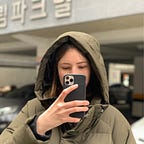Once we had received the photos, notes and recordings from our participants we got to work placing them into our designs. The information covered three situations:
- Taking the MTR (subway) in Hong Kong
- Getting lost and asking for directions in Seoul, South Korea
- Figuring out a weekly meal plan in Beirut, Lebanon
We were pleased to see that there was a wide variety of situations recorded, and that the data fit nicely into our designs.
Testing
We needed to be able to confirm that users can use and understand the prototype without an in-depth explanation from us. Thus, it was important to test our designs to ensure this.
For ease of testing (and lack of time) we decided to prototype only one of the three situations collected: the Hong Kong MTR. Our prototype, being its content is now situated in Hong Kong, was mostly in Cantonese. This narrowed our testing audience to those who are learning, or can speak Cantonese. We were able to find three people to test with: my brother (who gave me the data), my father (who also lives in Hong Kong, and is learning the language), and Sylvester (from our course, who is fluent in both Mandarin and Cantonese).
The test was successful, with every participant stating that they would use this app themselves. Two participants mentioned, however, that the organisation of information within the scenarios needed to be developed, as it currently has minimal information hierarchy.
Two participants noted that they felt a community aspect was missing, as right now it is a solitary experience and you cannot easily find out if what you are learning is incorrect. Due to time restraints, we were not able to prototype the collaborative aspect we discussed last week. Although this was a shame, we decided that this was the best plan to end with a more complete final outcome. However, we agreed that this feature would have added more depth to our project.
Finally, we noticed that during testing we needed to provide a fair amount of explanation for the participants to understand what scenarios are, and their functionality. This was frustrating to hear, however, we took this onboard and thought about how we could improve this. It could be because we had not prototyped an introduction/onboarding process to the app that would explain to a user what things are, and how to use them. Because we did not have sufficient time to fully design and implement this change, we decided to record an introductory video to the app to help explain key features. Although I acknowledge that it would have been better to implement changes that augment the design and flow of the app to be more intuitive, we simply did not have the time to do so.
Next steps
Because we were facing a looming deadline in a couple of days, we could not develop the community or explanatory aspects to the experience (especially because we also had to balance our work load with writing our essays!). Our next and final steps were to fill out gaps in the interactions on the prototype so that it would be ready for the video we wanted to film.
>>> For my next, and final post on the project, click here.
